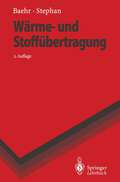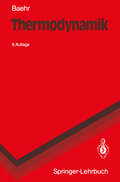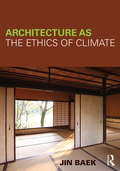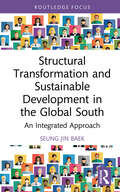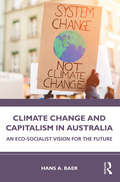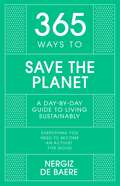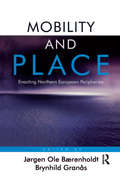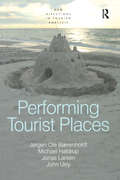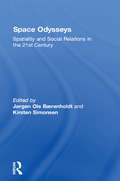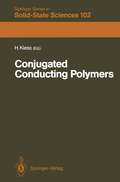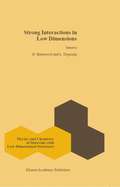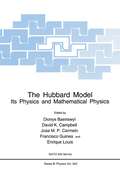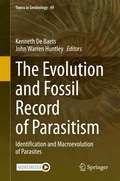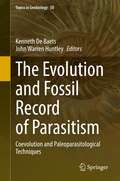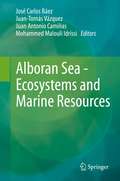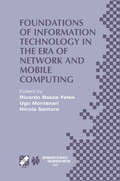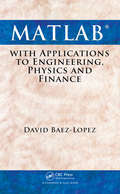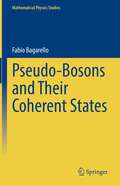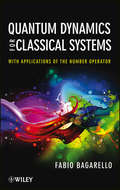- Table View
- List View
Wärme- und Stoffübertragung (Springer-Lehrbuch)
by Hans D. Baehr Karl StephanDieses bereits in zweiter Auflage vorliegende Lehrbuch ist eine umfassende und gründliche Darstellung der Wärme- und Stoffübertragung. Ihre Theorie wird systematisch entwickelt, und die Lösungsmethoden aller wichtigen Probleme werden ausführlich behandelt. Daher eignet sich dieses Buch nicht nur für Studenten, sondern nützt auch Wissenschaftlern und Ingenieuren in der Praxis als zuverlässiges Nachschlagewerk. Alle Gebiete der Wärme- und Stoffübertragung werden dargestellt: Wärmeleitung und Diffusion, konvektiver Wärme- und Stoffaustausch, Wärmetransport beim Kondensieren und Verdampfen, die Wärmestrahlung sowie die Berechnung der Wärme- und Stoffübertragung. Zahlreiche durchgerechnete Beispiele sowie Übungsaufgaben und Lösungen erleichtern das Verständnis.
Thermodynamik: Eine Einführung in die Grundlagen und ihre technischen Anwendungen (Springer-Lehrbuch)
by Hans Dieter BaehrArchitecture as the Ethics of Climate
by Jin BaekAt a time when climate and ethics have become so important to architectural debate, this book proposes an entirely new way for architects to engage with these core issues. Drawing on Tetsuro Watsuji‘s (1889-1960) philosophy, the book illuminates climate not as a collection of objective natural phenomena, but as a concrete form of bond in which "who we are"—the subjective human experience—is indivisibly intertwined with the natural phenomena. The book further elucidates the inter-personal nature of climatic experiences, criticizing a view that sees atmospheric effects of climate under the guise of personal experientialism and reinforcing the linkage between climate and ethos as the appropriateness of a setting for human affairs. This ethical premise of climate stretches the horizon of sustainability as pertaining not only to man’s solitary relationship with natural phenomena—a predominant trend in contemporary discourse of sustainability—but also to man’s relationship with man. Overcoming climatic determinism—regional determinism, too—and expanding the ethics of the inter-personal to the level where the whole and particulars are joined through the dialectics of the mutually-negating opposites, Jin Baek develops a new thesis engaging with the very urgent issues inherent in sustainable architecture. Crucially, the book explores examples that join climate and the dynamics of the inter-personal, including: Japanese vernacular residential architecture the white residential architecture of Richard Neutra contemporary architectural works and urban artifacts by Tadao Ando and Aldo Rossi Beautifully illustrated, this book is an important contribution to the discourse which surrounds architecture, climate and ethics and encourages the reader to think more broadly about how to respond to the current challenges facing the profession.
Architecture as the Ethics of Climate
by Jin BaekAt a time when climate and ethics have become so important to architectural debate, this book proposes an entirely new way for architects to engage with these core issues. Drawing on Tetsuro Watsuji‘s (1889-1960) philosophy, the book illuminates climate not as a collection of objective natural phenomena, but as a concrete form of bond in which "who we are"—the subjective human experience—is indivisibly intertwined with the natural phenomena. The book further elucidates the inter-personal nature of climatic experiences, criticizing a view that sees atmospheric effects of climate under the guise of personal experientialism and reinforcing the linkage between climate and ethos as the appropriateness of a setting for human affairs. This ethical premise of climate stretches the horizon of sustainability as pertaining not only to man’s solitary relationship with natural phenomena—a predominant trend in contemporary discourse of sustainability—but also to man’s relationship with man. Overcoming climatic determinism—regional determinism, too—and expanding the ethics of the inter-personal to the level where the whole and particulars are joined through the dialectics of the mutually-negating opposites, Jin Baek develops a new thesis engaging with the very urgent issues inherent in sustainable architecture. Crucially, the book explores examples that join climate and the dynamics of the inter-personal, including: Japanese vernacular residential architecture the white residential architecture of Richard Neutra contemporary architectural works and urban artifacts by Tadao Ando and Aldo Rossi Beautifully illustrated, this book is an important contribution to the discourse which surrounds architecture, climate and ethics and encourages the reader to think more broadly about how to respond to the current challenges facing the profession.
Structural Transformation and Sustainable Development in the Global South: An Integrated Approach (Routledge Explorations in Development Studies)
by Seung Jin BaekThis book investigates the relationship between sustainable development and structural transformation within international development policy. On the one hand, sustainable development is promoted as a multi-dimensional concept for achieving environmentally and socially responsible change. On the other hand, structural transformation refers to a sustained period of growth in living standards and incomes that brings sectoral change. For some, these two objectives seem at odds with each other, but this book argues that incorporating environmental initiatives into structural transformation goals in lower-income countries actually results in better results than strategies prioritising economic growth. Drawing on extensive structural equation modelling and original analysis, the book presents an innovative inclusive sustainable development framework to demonstrate the benefits of a more integrated approach to development planning, aiming for structural transformation in line with inclusive sustainable development principles. This book will be of interest to students and researchers of global development, and to policymakers within government and development organizations.
Structural Transformation and Sustainable Development in the Global South: An Integrated Approach (Routledge Explorations in Development Studies)
by Seung Jin BaekThis book investigates the relationship between sustainable development and structural transformation within international development policy. On the one hand, sustainable development is promoted as a multi-dimensional concept for achieving environmentally and socially responsible change. On the other hand, structural transformation refers to a sustained period of growth in living standards and incomes that brings sectoral change. For some, these two objectives seem at odds with each other, but this book argues that incorporating environmental initiatives into structural transformation goals in lower-income countries actually results in better results than strategies prioritising economic growth. Drawing on extensive structural equation modelling and original analysis, the book presents an innovative inclusive sustainable development framework to demonstrate the benefits of a more integrated approach to development planning, aiming for structural transformation in line with inclusive sustainable development principles. This book will be of interest to students and researchers of global development, and to policymakers within government and development organizations.
Climate Change and Capitalism in Australia: An Eco-Socialist Vision for the Future
by Hans A. BaerRecognizing that climate politics has been an increasingly contentious and heated topic in Australia over the past two decades, this book examines Australian capitalism as a driver of climate change and the nexus between the corporations and Coalition and Australian Labor parties. As a highly developed country, Australia is punching above its weight in terms of contributing to greenhouse gas emissions despite rising temperatures, droughts, water shortages and raging bushfires, storm surges and flooding, and the bleaching of the Great Barrier Reef. Drawing upon both archival and ethnographic research, Hans Baer examines Australian climate politics at the margins, namely the Greens, the labour union, the environmental NGOs, and the grass-roots climate movement. Adopting a climate justice perspective which calls for "system change, not climate change" as opposed to the conventional approach of seeking to mitigate emissions through market mechanisms and techno-fixes, particularly renewable energy sources, this book posits system-challenging transitional steps to shift Australia toward an eco-socialist vision in keeping with a burgeoning global socio-ecological revolution. Accessibly written and including an interview with renowned comedian and climate activist Rod Quantock OAM, this book is essential reading for academics, students and general readers with an interest in climate change and climate activism.
Climate Change and Capitalism in Australia: An Eco-Socialist Vision for the Future
by Hans A. BaerRecognizing that climate politics has been an increasingly contentious and heated topic in Australia over the past two decades, this book examines Australian capitalism as a driver of climate change and the nexus between the corporations and Coalition and Australian Labor parties. As a highly developed country, Australia is punching above its weight in terms of contributing to greenhouse gas emissions despite rising temperatures, droughts, water shortages and raging bushfires, storm surges and flooding, and the bleaching of the Great Barrier Reef. Drawing upon both archival and ethnographic research, Hans Baer examines Australian climate politics at the margins, namely the Greens, the labour union, the environmental NGOs, and the grass-roots climate movement. Adopting a climate justice perspective which calls for "system change, not climate change" as opposed to the conventional approach of seeking to mitigate emissions through market mechanisms and techno-fixes, particularly renewable energy sources, this book posits system-challenging transitional steps to shift Australia toward an eco-socialist vision in keeping with a burgeoning global socio-ecological revolution. Accessibly written and including an interview with renowned comedian and climate activist Rod Quantock OAM, this book is essential reading for academics, students and general readers with an interest in climate change and climate activism.
365 Ways to Save the Planet: A Day-by-day Guide to Living Sustainably (365 Series)
by Nergiz De BaereARE YOU READY TO CHANGE THE WORLD?365 WAYS TO SAVE THE PLANET is a full year's worth of daily wisdom, carefully selected to inspire you to take the urgent action our very existence desperately needs. You'll find actions and challenges, surprising facts about the climate crisis, templates for writing to political representatives, scientific explanations of important concepts, popular misconceptions about sustainability, and much more. 365 WAYS TO SAVE THE PLANET goes way beyond predictable sustainability advice about how to recycle. Here you'll discover the small stuff you can do every day to change the world. Because when you get the little things right, the big things follow.
Mobility and Place: Enacting Northern European Peripheries
by Jørgen Ole Bærenholdt Brynhild GranåsThe Northern peripheries of Europe, which are covered by this book, are associated with remoteness, the frontier, isolated communities, colonialism and resource extraction. Recently, huge projects in petroleum and hydropower have been located there, and the region has become better known as an attractive tourist destination. Although these spaces are perceived as being marginal, they are inhabited and linked into globalization and international agendas. This book examines how people live in such remote spaces in an emerging global world of connectivity, interdependency, mobility and non-linear dynamics. The various case studies examine a wide range of experiences, ranging from tourists and local settlers to those who migrate for labour in old or new industries, or to pursue the hybrid urban/rural life of the periphery. In this book, mobility and place come together. The analyses demonstrate how mobility and place mutually constitute each other and how specific relationships between the two aspects are crucial in the making of societies. The authors study attempts to reinvent places, together with connections and the opening of 'new scapes' in order to sustain businesses, municipalities and people's livelihood.
Mobility and Place: Enacting Northern European Peripheries
by Jørgen Ole Bærenholdt Brynhild GranåsThe Northern peripheries of Europe, which are covered by this book, are associated with remoteness, the frontier, isolated communities, colonialism and resource extraction. Recently, huge projects in petroleum and hydropower have been located there, and the region has become better known as an attractive tourist destination. Although these spaces are perceived as being marginal, they are inhabited and linked into globalization and international agendas. This book examines how people live in such remote spaces in an emerging global world of connectivity, interdependency, mobility and non-linear dynamics. The various case studies examine a wide range of experiences, ranging from tourists and local settlers to those who migrate for labour in old or new industries, or to pursue the hybrid urban/rural life of the periphery. In this book, mobility and place come together. The analyses demonstrate how mobility and place mutually constitute each other and how specific relationships between the two aspects are crucial in the making of societies. The authors study attempts to reinvent places, together with connections and the opening of 'new scapes' in order to sustain businesses, municipalities and people's livelihood.
Performing Tourist Places (New Directions in Tourism Analysis)
by Jørgen Ole Bærenholdt Michael Haldrup John UrryThis book looks at the making and the consuming of places in the contemporary world. Illustrated through various case-studies from Denmark, it considers how places, performances and peoples intersect. It examines the fascinating circumstances through which visitors to a place, in part, produce that place through their performances. Places are intertwined with people through various systems that generate and reproduce performances in and of that place. These systems comprise networks of ’hosts, guests, buildings, objects and machines’ that contingently realize particular performances of specific places. The studies featured here develop an exciting ’new mobility’ paradigm emerging within the social sciences.
Performing Tourist Places (New Directions in Tourism Analysis)
by Jørgen Ole Bærenholdt Michael Haldrup John UrryThis book looks at the making and the consuming of places in the contemporary world. Illustrated through various case-studies from Denmark, it considers how places, performances and peoples intersect. It examines the fascinating circumstances through which visitors to a place, in part, produce that place through their performances. Places are intertwined with people through various systems that generate and reproduce performances in and of that place. These systems comprise networks of ’hosts, guests, buildings, objects and machines’ that contingently realize particular performances of specific places. The studies featured here develop an exciting ’new mobility’ paradigm emerging within the social sciences.
Space Odysseys: Spatiality and Social Relations in the 21st Century
by Jørgen Ole Bærenholdt Kirsten SimonsenThe nature of spatial imaginations has become central to a range of major social and political debates. Narratives on spatial inequality, from the North-South divide in global economic and political visions, to marginalisation and 'ghettoisation' in Western cities, appear regularly in our daily newspapers. Such examples indicate that issues of space/spatiality are as crucial in our current societies as never before. 'Space Odysseys' brings together leading social scientists including John Urry and Derek Gregory to address a number of central issues in spatiality and social relations in the early 21st century. Starting from the presupposition that space is a social dimension and a social construct, it then presents examples of these conceptions of space at work. While the book title's indirect reference to the film '2001: A Space Odyssey' indicates the contributors' interest in questions of voyages and mobility, the plural use shows that the approaches to this conceptual exploration are multiple, reflecting differences in experience, in social context and/or in gender, class and ethnicity. The book is divided into three main sections. The first explores issues of 'mobility, immobility and embodied narratives', the second section deals with 'territoriality, mobility and identity politics and the final section concludes with chapters on 'the spatial production of knowledge'.
Space Odysseys: Spatiality and Social Relations in the 21st Century
by Jørgen Ole Bærenholdt Kirsten SimonsenThe nature of spatial imaginations has become central to a range of major social and political debates. Narratives on spatial inequality, from the North-South divide in global economic and political visions, to marginalisation and 'ghettoisation' in Western cities, appear regularly in our daily newspapers. Such examples indicate that issues of space/spatiality are as crucial in our current societies as never before. 'Space Odysseys' brings together leading social scientists including John Urry and Derek Gregory to address a number of central issues in spatiality and social relations in the early 21st century. Starting from the presupposition that space is a social dimension and a social construct, it then presents examples of these conceptions of space at work. While the book title's indirect reference to the film '2001: A Space Odyssey' indicates the contributors' interest in questions of voyages and mobility, the plural use shows that the approaches to this conceptual exploration are multiple, reflecting differences in experience, in social context and/or in gender, class and ethnicity. The book is divided into three main sections. The first explores issues of 'mobility, immobility and embodied narratives', the second section deals with 'territoriality, mobility and identity politics and the final section concludes with chapters on 'the spatial production of knowledge'.
Conjugated Conducting Polymers (Springer Series in Solid-State Sciences #102)
by D. Baeriswyl D. K. Campbell G. C. Clark G. Harbeke P. K. Kahol H. Kiess S. Mazumdar M. Mehring W. RehwaldThis book reviews the current understanding of electronic, optical and magnetic properties of conjugated polymers in both the semiconducting and metallic states. It introduces in particular novel phenomena and concepts in these quasi one-dimensional materials that differ from the well-established concepts valid for crystalline semiconductors. After a brief introductory chapter, the second chapter presents basic theore tical concepts and treats in detail the various models for n-conjugated polymers and the computational methods required to derive observable quantities. Specific spatially localized structures, often referred to as solitons, polarons and bipolarons, result naturally from the interaction between n-electrons and lattice displacements. For a semi-quantitative understanding of the various measure ments, electron-electron interactions have to be incorporated in the models; this in turn makes the calculations rather complicated. The third chapter is devoted to the electrical properties of these materials. The high metallic conductivity achieved by doping gave rise to the expression conducting polymers, which is often used for such materials even when they are in their semiconducting or insulating state. Although conductivity is one of the most important features, the reader will learn how difficult it is to draw definite conclusions about the nature of the charge carriers and the microscopic transport mechanism solely from electrical measurements. Optical properties are discussed in the fourth chapter.
Strong Interactions in Low Dimensions (Physics and Chemistry of Materials with Low-Dimensional Structures #25)
by D. Baeriswyl L. DegiorgiThis book provides an attempt to convey the colorful facets of condensed matter systems with reduced dimensionality. Some of the specific features predicted for interacting one-dimensional electron systems, such as charge- and spin-density waves, have been observed in many quasi-one-dimensional materials. The two-dimensional world is even richer: besides d-wave superconductivity and the Quantum Hall Effect - perhaps the most spectacular phases explored during the last two decades - many collective charge and spin states have captured the interest of researchers, such as charge stripes or spontaneously generated circulating currents. Recent years have witnessed important progress in material preparation, measurement techniques and theoretical methods. Today larger and better samples, higher flux for neutron beams, advanced light sources, better resolution in electron spectroscopy, new computational algorithms, and the development of field-theoretical approaches allow an in-depth analysis of the complex many-body behaviour of low-dimensional materials. The epoch when simple mean-field arguments were sufficient for describing the gross features observed experimentally is definitely over. The Editors' aim is to thoroughly explain a number of selected topics: the application of dynamical probes, such as neutron scattering, optical absorption and photoemission, as well as transport studies, both electrical and thermal. Some of the more theoretical chapters are directly relevant for experiments, such as optical spectroscopy, transport in one-dimensional models, and the phenomenology of charge inhomogeneities in layered materials, while others discuss more general topics and methods, for example the concept of a Luttinger liquid and bosonization, or duality transformations, both promising tools for treating strongly interacting many-body systems.
The Hubbard Model: Its Physics and Mathematical Physics (Nato Science Series B: #343)
by Dionys Baeriswyl David K. Campbell Jose M. P. Carmelo Francisco Guinea Enrique LouisIn the slightly more than thirty years since its formulation, the Hubbard model has become a central component of modern many-body physics. It provides a paradigm for strongly correlated, interacting electronic systems and offers insights not only into the general underlying mathematical structure of many-body systems but also into the experimental behavior of many novel electronic materials. In condensed matter physics, the Hubbard model represents the simplest theoret ical framework for describing interacting electrons in a crystal lattice. Containing only two explicit parameters - the ratio ("Ujt") between the Coulomb repulsion and the kinetic energy of the electrons, and the filling (p) of the available electronic band - and one implicit parameter - the structure of the underlying lattice - it appears nonetheless capable of capturing behavior ranging from metallic to insulating and from magnetism to superconductivity. Introduced originally as a model of magnetism of transition met als, the Hubbard model has seen a spectacular recent renaissance in connection with possible applications to high-Tc superconductivity, for which particular emphasis has been placed on the phase diagram of the two-dimensional variant of the model. In mathematical physics, the Hubbard model has also had an essential role. The solution by Lieb and Wu of the one-dimensional Hubbard model by Bethe Ansatz provided the stimulus for a broad and continuing effort to study "solvable" many-body models. In higher dimensions, there have been important but isolated exact results (e. g. , N agoaka's Theorem).
The Evolution and Fossil Record of Parasitism: Identification and Macroevolution of Parasites (Topics in Geobiology #49)
by Kenneth De Baets John Warren HuntleyThis two-volume edited book highlights and reviews the potential of the fossil record to calibrate the origin and evolution of parasitism, and the techniques to understand the development of parasite-host associations and their relationships with environmental and ecological changes. The book deploys a broad and comprehensive approach, aimed at understanding the origins and developments of various parasite groups, in order to provide a wider evolutionary picture of parasitism as part of biodiversity. This is in contrast to most contributions by parasitologists in the literature that focus on circular lines of evidence, such as extrapolating from current host associations or distributions, to estimate constraints on the timing of the origin and evolution of various parasite groups. This approach is narrow and fails to provide the wider evolutionary picture of parasitism on, and as part of, biodiversity. Volume one focuses on identifying parasitism in the fossil record, and sheds light on the distribution and ecological importance of parasite-host interactions over time. In order to better understand the evolutionary history of parasites and their relationship with changes in the environment, emphasis is given to viruses, bacteria, protists and multicellular eukaryotes as parasites. Particular attention is given to fungi and metazoans such as bivalves, cnidarians, crustaceans, gastropods, helminths, insects, mites and ticks as parasites. Researchers, specifically evolutionary (paleo)biologists and parasitologists, interested in the evolutionary history of parasite-host interactions as well as students studying parasitism will find this book appealing.
The Evolution and Fossil Record of Parasitism: Coevolution and Paleoparasitological Techniques (Topics in Geobiology #50)
by Kenneth De Baets John Warren HuntleyThis two-volume edited book highlights and reviews the potential of the fossil record to calibrate the origin and evolution of parasitism, and the techniques to understand the development of parasite-host associations and their relationships with environmental and ecological changes. The book deploys a broad and comprehensive approach, aimed at understanding the origins and developments of various parasite groups, in order to provide a wider evolutionary picture of parasitism as part of biodiversity. This is in contrast to most contributions by parasitologists in the literature that focus on circular lines of evidence, such as extrapolating from current host associations or distributions, to estimate constraints on the timing of the origin and evolution of various parasite groups. This approach is narrow and fails to provide the wider evolutionary picture of parasitism on, and as part of, biodiversity.Volume two focuses on the importance of direct host associations and host responses such as pathologies in the geological record to constrain the role of antagonistic interactions in driving the diversification and extinction of parasite-host relationships and disease. To better understand the impact on host populations, emphasis is given to arthropods, colonial metazoans, echinoderms, mollusks and vertebrates as hosts. In addition, novel techniques used to constrain interactions in deep time are discussed ranging from chemical and microscopic investigations of host remains, such as blood and coprolites, to the statistical inference of lateral transfer of transposons and host-parasite coevolutionary dynamics using molecular divergence time estimation.
Alboran Sea - Ecosystems and Marine Resources
by José Carlos Báez Juan-Tomás Vázquez Juan Antonio Camiñas Mohammed Malouli IdrissiThe Alboran Sea represents a regional Mediterranean space where North and South worlds merges, creating a geopolitical region where marine resources and maritime activities should be managed from a national and international perspectives. It is widely known, that currently the planet is suffering a global change, and it is also affecting the Alboran Sea, its ecosystems and populations. An important first step to update a paramount vision on this region is to understand the climatic, geologic and oceanographic, including biochemical cycles, process which shapes the rich geodiversity, biodiversity, the productivity, and the sustainable use of the marine resources from Alboran Sea. The fisheries management system should take into account marine environmental variability to achieve biological sustainability of marine resources. Well-funded policy-makers’ decisions require a sound science based knowledge of the interaction between the marine environment and commercial stocks. This is because the role of marine environment in the evolution of fish stocks is sometimes even more important than the one played by fishers in the commercial exploitation of them. Finally, we should analyze the different aspects of political context that could affect the management of the resources from Alboran Sea in the context of climate change. This book reviews different aspects of the Alboran Sea to help understand the current situation from the original Tethis Ocean. The book is divided into four blocks: (i) Oceanographic, geological and ecological context (chapters 2 to 7), (ii) biodiversity and ecosystems distribution (chapters 8 to 12), (iii) fisheries resources and aquaculture (chapters 13 to 20), and (iv) conservation, management and marine polices (chapters 21 to 25).
Foundations of Information Technology in the Era of Network and Mobile Computing: IFIP 17th World Computer Congress — TC1 Stream / 2nd IFIP International Conference on Theoretical Computer Science (TCS 2002) August 25–30, 2002, Montréal, Québec, Canada (IFIP Advances in Information and Communication Technology #96)
by Ricardo Baeza-Yates Ugo Montanari Nicola SantoroFoundations of Information Technology in the Era of Network and Mobile Computing is presented in two distinct but interrelated tracks: -Algorithms, Complexity and Models of Computation; -Logic, Semantics, Specification and Verification.This volume contains 45 original and significant contributions addressing these foundational questions, as well as 4 papers by outstanding invited speakers. These papers were presented at the 2nd IFIP International Conference on Theoretical Computer Science (TCS 2002), which was held in conjunction with the 17th World Computer Congress, sponsored by the International Federation for Information Processing (IFIP), and which convened in Montréal, Québec, Canada in August 2002.
MATLAB with Applications to Engineering, Physics and Finance
by David Baez-LopezMaster the tools of MATLAB through hands-on examplesShows How to Solve Math Problems Using MATLABThe mathematical software MATLAB integrates computation, visualization, and programming to produce a powerful tool for a number of different tasks in mathematics. Focusing on the MATLAB toolboxes especially dedicated to science, finance, and engineering
Pseudo-Bosons and Their Coherent States (Mathematical Physics Studies)
by Fabio BagarelloThis book is based on the analysis of canonical commutation relations (CCRs) and their possible deformations. In light of the recent interest on PT-quantum mechanics, the author presents a special deformed version of the CCRs, and discusses the consequences of this deformation both from a mathematical side, and for its possible applications to physics. These include the analysis of several non self-adjoint Hamiltonians, a novel view to the position and momentum operators, and a general approach to compute path integrals and transition probabilities using the so-called bi-coherent states. The book is meant for researchers and is also suited for advanced students. It can be used as a gentle introduction to some delicate aspects in functional analysis and in quantum mechanics for non self-adjoint observables.
Quantum Dynamics for Classical Systems: With Applications of the Number Operator
by Fabio BagarelloIntroduces number operators with a focus on the relationship between quantum mechanics and social science Mathematics is increasingly applied to classical problems in finance, biology, economics, and elsewhere. Quantum Dynamics for Classical Systems describes how quantum tools—the number operator in particular—can be used to create dynamical systems in which the variables are operator-valued functions and whose results explain the presented model. The book presents mathematical results and their applications to concrete systems and discusses the methods used, results obtained, and techniques developed for the proofs of the results. The central ideas of number operators are illuminated while avoiding excessive technicalities that are unnecessary for understanding and learning the various mathematical applications. The presented dynamical systems address a variety of contexts and offer clear analyses and explanations of concluded results. Additional features in Quantum Dynamics for Classical Systems include: Applications across diverse fields including stock markets and population migration as well as a unique quantum perspective on these classes of models Illustrations of the use of creation and annihilation operators for classical problems Examples of the recent increase in research and literature on the many applications of quantum tools in applied mathematics Clarification on numerous misunderstandings and misnomers while shedding light on new approaches in the field Quantum Dynamics for Classical Systems is an ideal reference for researchers, professionals, and academics in applied mathematics, economics, physics, biology, and sociology. The book is also excellent for courses in dynamical systems, quantum mechanics, and mathematical models.
